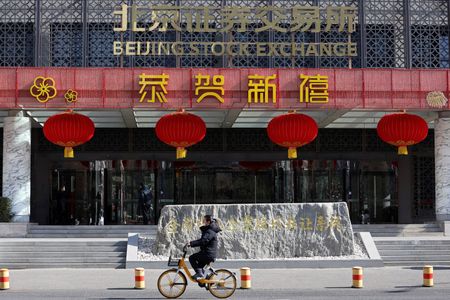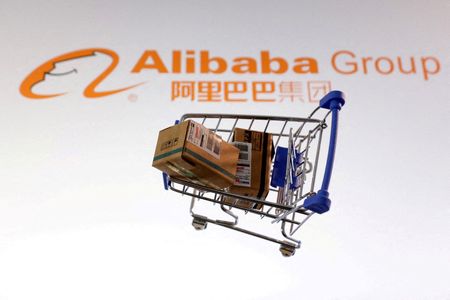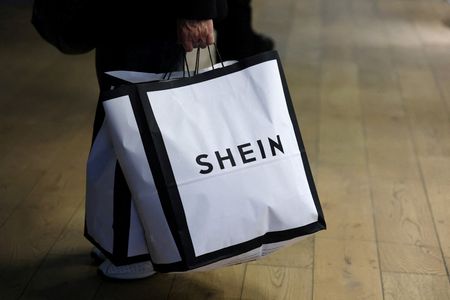By Samuel Shen and Vidya Ranganathan
SHANGHAI/SINGAPORE (Reuters) – As China directs its large financial institutions to help revive and rebalance a struggling stock market, analysts see merit in the plan but are sceptical it will stimulate a recovery.
Beijing has used this playbook before to some success. Now, however, it is in a vicious chicken-and-egg cycle where the stock market and weak economy feed off each other, hobbling consumer spending and private investment.
The benchmark CSI 300 index is down 1% this year and overall, those who have waited patiently since China’s post-pandemic reopening two years ago have lost 9% in Chinese stocks.
Seeking a circuit breaker, the Communist Party aims to use state funds to mimic the “animal spirits” of capitalism. State insurers and mutual funds have been asked to pump billions of dollars that could prop up the stock market.
“I understand why they’re doing this right now,” said Francis Tan, chief Asia strategist at CA Indosuez.
“If you can fix the asset prices, confidence will be up and when the confidence will be up, there’ll be real economic demand and then we’ll see economic growth. So they’re coming in from the asset price angle to fix sentiment. They are now trying to start a virtuous cycle,” he said.
The world’s second-largest economy is in desperate need of a feel-good factor as deepening deflation, a slump in property values, government debt problems and, more recently, a fresh trade war with the United States sap sentiment.
Regulators have touted the idea of luring more long-term investors into the retail-dominated stock market for more than a decade. But this time they have set specific targets.
China Securities Regulatory Commission (CSRC) head Wu Qing has said big state insurers are to invest 30% of their new policy premiums in China-listed shares and mutual funds to grow stock holdings by 10% a year for the next three years.
Wu also expects insurers to channel at least 100 billion yuan ($13.8 billion) into stocks via a pilot scheme in the first half of this year.
Mutual funds are scurrying to launch more equity investment offerings to comply with that directive. More than 100 equity funds are being marketed or in the sales pipeline, according to data provider East Money Information Co.
The new rules are estimated to attract at least 1 trillion yuan ($138.1 billion) from insurers and mutual funds into domestic stocks each year, although that’s a pittance for a $12 trillion market.
BALLAST AND STABILISER
While the measures have not yet spurred a market rally, they may over time attract more professional investors that become the ‘ballast’ and ‘stabiliser’ that CSRC’s Wu hopes for.
Four years into a bear market, the CSI 300 index trades where it did a decade ago. The total value of the market, dominated by small-cap firms favoured by retail investors and rife with pump-and-dump speculation, has not changed since 2015.
Sat Duhra, a portfolio manager at Janus Henderson, believes China needs to address underlying macroeconomic issues for these efforts to have a lasting impact.
“If you go back over history and look at what was important for consumption in China, it was household income … and that’s employment. It was not equity market creating wealth effect and it was not interest rates,” he said.
Institutional investors own around 19% of tradable shares in China, dwarfed by retail traders who own 30%, according to Huaxi Securities. Individuals constitute 70% of daily turnover.
Dong Baozhen, chairman of Beijing-based asset manager Lingtong Shengtai, says the measures are a “way out” for the fragile stock market.
“The cyclical boom and bust of Chinese shares over the past three decades was the result of pricing power resting in the wrong hands”, so the government has a strong political will to seize that power from speculators, he said.
He reckons Beijing’s carrot-and-stick approach will boost the clout of risk-averse insurers currently under-represented in the market, potentially benefiting stocks with high dividends, such as banks.
Stock investments by insurers have already jumped by a third over the past four months to 4.4 trillion yuan under the government’s push. That compares with roughly 7 trillion yuan of equity holdings by mutual funds.
Still, some analysts question the wisdom of making long-term bets on a slowing economy facing persistent deflation, an aging population and geopolitical tensions.
“The core issue is not really the nature of the capital, it’s the market environment,” said Zhang Jianan, a self-employed stock trader.
“You’ve got public funds as potatoes, you’ve got insurance funds as roses. You sprinkle it in the soil and it will grow, but you sprinkle it in a shit hole and they will all die.”
($1 = 7.2440 Chinese yuan)
(Reporting by Samuel Shen in Shanghai and Summer Zhen, Jiaxin Li in Hong Kong, Rae Wee in Singapore; Editing by Jacqueline Wong)











